Download Pdf [2,32 MB] - MTU Aero Engines
Download Pdf [2,32 MB] - MTU Aero Engines
Download Pdf [2,32 MB] - MTU Aero Engines
Create successful ePaper yourself
Turn your PDF publications into a flip-book with our unique Google optimized e-Paper software.
Anecdotes<br />
Retired B-52s at the Davis Monthan Air Force Base.<br />
While most of the aircraft here are waiting to<br />
get back into the air, chances for a comeback<br />
are slim for the airplanes parked in the<br />
desert. Since the terrorist attacks on<br />
September 11, 2001, and the deep crisis of<br />
many airlines, especially U.S.-based, the aircraft<br />
parking lots and graveyards in the<br />
American deserts are experiencing an unexpected<br />
boom: while in the ’90s, 700 to 1,000<br />
of the 15,000 commercial transports existing<br />
worldwide were mothballed, that number<br />
rose to 2,400 about a year after the attacks,<br />
which compares with the 2,000 or so still<br />
parked today. Apart from Marana, Arizona<br />
has two more major parking lots: in<br />
Goodyear near Phoenix and in Tucson. At<br />
times, some 400 jobless transports congregate<br />
there. A very impressive sight also is the<br />
site of the Davis Monthan Air Force Base<br />
south of Tucson, where thousands of surplus<br />
military aircraft are assembled, plus<br />
large fleets of commercial veterans, like<br />
Boeing 707s.<br />
At Evergreen in Marana, the first make-orbreak<br />
test came during the Asia crisis in the<br />
late ’90s: “At that time, we temporarily had<br />
30 brand-new jets sitting around here,<br />
among them many Boeing 747-400s of<br />
which airlines like Philippines, Korean Air,<br />
Asiana and Garuda had not taken delivery,”<br />
said Wally Flannery, a 35-year veteran with<br />
Evergreen. He went on to explain: “With<br />
34 REPORT<br />
Boeing, we have the status of an official<br />
delivery center, which means we can transfer<br />
such planes directly to new takers.” The fortunes<br />
of the global aviation economy, then,<br />
reflect very much in the inventory sitting on<br />
the 185-hectare Evergreen grounds before<br />
the background of the jagged Sawtooth<br />
Mountains. Nowhere in the world have as<br />
many aircraft ever been parked as here, and<br />
scrapped, too: a total of 1,500 planes since<br />
the ’70s. And still counting: so far, each year<br />
some 180 airliners are being stripped worldwide,<br />
many of them in Marana. During the<br />
past ten years, the share of first-generation<br />
widebodies among scrap candidates—early<br />
Boeing 747 models, as well as DC-10s,<br />
Lockheed TriStars and Airbus A300 and<br />
A310s, most recently also Boeing 767s—has<br />
been growing.<br />
Often, the engines are worth more than the<br />
old aircraft themselves, and Evergreen is still<br />
cashing in as much as half a million dollars<br />
on the sale of a single jet engine, tested and<br />
recertified, naturally. The operators profit<br />
from the investments made in advanced<br />
engines and innovative maintenance. The<br />
majority of the 150 jets, no less, that were<br />
parked at Marana after 9/11 and went back<br />
into revenue service from there had engines<br />
with <strong>MTU</strong> content. The Evergreen people are<br />
not only parking and wrecking aircraft, they<br />
are also doing all types of modification. Most<br />
Awaiting metal recycling are veteran engines stacked up near Tucson, Arizona.<br />
On a retired DC-10, the rear engine has already been removed.<br />
prominent customer is the NASA space<br />
agency, which continually has one of its two<br />
Boeing 747 shuttle carrier aircraft overhauled<br />
and serviced here. “It’s a cool job and<br />
what’s more, there’s money in it,” enthuses<br />
Al Sharif of Evergreen Marketing.<br />
Even if only ten percent of the Evergreen Air<br />
Center’s revenue comes from storing aircraft,<br />
it’s a very special business nonetheless.<br />
Ambient conditions are ideal: the dry<br />
desert air and only very rare summer rains<br />
just about preclude corrosion, a fuselage’s<br />
worst enemy. But still, there’s more to it than<br />
just parking an aircraft and waiting for it to<br />
be sold or wrecked. In accordance with customer’s<br />
instruction, landing gears are covered<br />
with foil, and windows and all openings<br />
are taped over. That keeps the intensive sunshine<br />
from damaging the cabin interior, and<br />
owls, rattlers and swarming bees from setting<br />
up house in the aircraft. To keep the<br />
temporarily grounded Marana fleet airworthy,<br />
a definite maintenance schedule needs<br />
to be observed. At certain intervals, the<br />
parked jets are moved to keep their tires<br />
from deteriorating. Also, workers are regularly<br />
actuating stabilizers and flaps and starting<br />
the engines. Importantly, the doors are frequently<br />
opened to circulate the air inside.<br />
“You can park a widebody for 1,000 bucks a<br />
month, and we get a 750-buck monthly standard<br />
charge for a smaller aircraft,” Flannery<br />
says, allowing a small grin to creep across<br />
his face. “It costs you more to park a car in<br />
downtown New York.”<br />
Wrecking is not an overly gentle job: a grab<br />
swings and tears large metal chunks out of<br />
the fuselage. When cannibalized, a jumbo-<br />
transport yields a respectable 68 tons aluminum<br />
and other waste metal to be recycled<br />
and perhaps turned into beer cans. “In a<br />
matter of three days, we’re turning a Boeing<br />
747 into 20 containers of metal scrap,”<br />
explains Flannery. “They fetch about 20,000<br />
dollars from a scrap dealer.” Each year, some<br />
two dozen widebody aircraft end their lifecycle<br />
in Marana. Add to that just as many of<br />
the smaller jets. “It’s sure to break the<br />
hearts of visiting pilots,” Flannery says.<br />
For additional information, contact<br />
Sabine Biesenberger<br />
+49 89 1489-2760<br />
This article is available online at:<br />
http://www.mtu.de/107Graveyard<br />
REPORT 35


![Download Pdf [2,32 MB] - MTU Aero Engines](https://img.yumpu.com/11154939/18/500x640/download-pdf-232-mb-mtu-aero-engines.jpg)


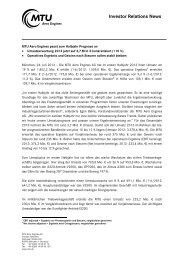
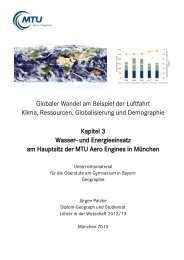
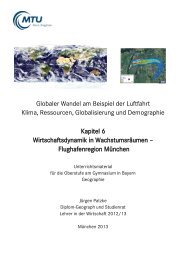
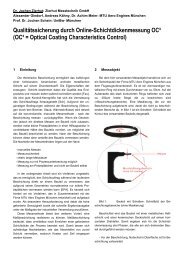
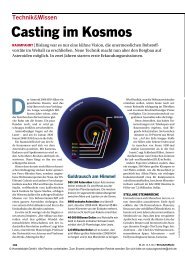


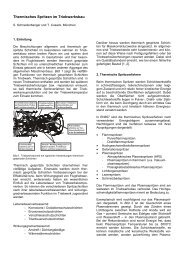
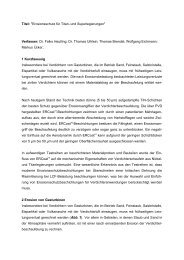



![Download PDF [5,37 MB] - MTU Aero Engines](https://img.yumpu.com/21945461/1/190x125/download-pdf-537-mb-mtu-aero-engines.jpg?quality=85)